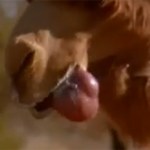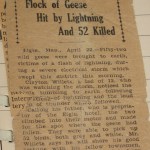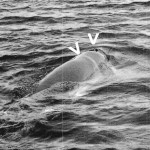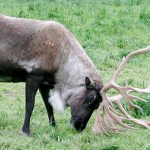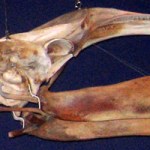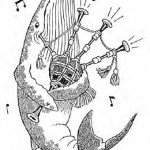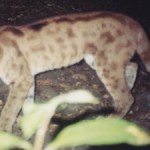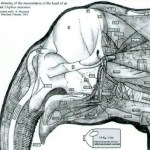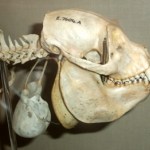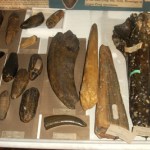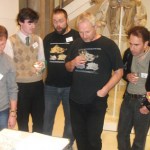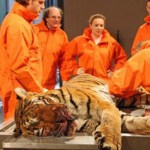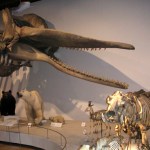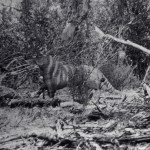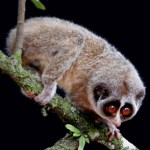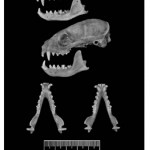mammalogy
Everybody knows that camels are weird. As you'll know if you've been keeping an eye on SV-POW! lately, we've recently been quite taken with their necks. But it's not just camel's necks that are weird. Here, we embark on another look at the sometimes bizarre pouches, pockets and sacs present in certain mammals, most of which are outgrowths of the respiratory system.
Relatively little known is that (some) camels possess an inflatable diverticulum on the palate, termed the dhula, dulaa, gulah, goola, qulla or pálu, and known technically as the vesica palatina or palatine diverticulum. It…
Back in July 2009 I wrote an article on what little I knew (and had read) about lightning strikes and animal deaths [in composite image below, lightning image by John R. Southern; Angolan giraffe Giraffa camelopardalis angolensis by Hans Hillewaert. Both from wikipedia].
As discussed therein, there are a few cases on record where African bush elephants Loxodonta africana have died after lightning strikes, and there are also references here and there to deaths of wild deer and rhino caused by lightning (so far, I've found one technical paper: Zele et al. (2006)). More impressive are the…
By now you might be relatively familiar with the bizarre soft tissue and bony anatomy of the peculiar, poorly known Pygmy right whale Caperea marginata [a juvenile Caperea that stranded on New Zealand is shown above; original image by New Zealand Department of Conservation, from Te Papa's Blog]. If you missed the relevant articles you might want to check them out here (on the giant, asymmetrical laryngeal pouch), here (on the vertebrae and ribs) and here (on the skull, ribs and tail). These articles (which were very much thrown together without any planning: they were spin-offs of the […
I really must get this series on pouches, sacs and pockets finished. Last time, we looked at baleen whales (and then I got distracted by Caperea): in these animals, a large, inflatable laryngeal sac is used in producing loud, resonating noises (though roles in gas storage or the mechanics of exhalation have also been suggested).
Another ventrally located laryngeal sac is present in the Reindeer Rangifer tarandus [photo above, by Karen Laubenstein, from wikipedia, shows an Alaskan reindeer with wonderfully elaborate antlers]. The sac originates from the trachea close to the epiglottis, is…
You know me, I'm not one to brag. But...
One of several interesting things I did over the weekend was attend a special cinema screening (in Clapham, London) of the giant squid special episode of Inside Nature's Giants. It was great, and the showing was followed by a Q&A session with David Dugan (ING writer/producer), presenter Mark Evans, and anatomist Joy Reidenberg. It was great to meet and chat with Joy - here's photographic proof. I gave her a copy of Tetrapod Zoology Book One*.
* Or... should that be Tetrapood Zoology Book One? The publishers are aware of the mistake and will be…
Given that we're all enjoying gawping at Caperea so much, I may as well finish up and use the rest of the photos that Joy Reidenberg kindly provided. First off, here's the skull from the side.
It's really weird: that lower jaw shape is utterly unlike anything else present in baleen whales, being comparatively deep and 'heavy' in appearance, with a downward flexure near the tip (is it just me, or does this look a bit like a flamingo mandible?). In comparison, the lower jaws of rorquals, grey whales are kin are laterally bowed, beam-like bones with cylindrical cross-sections. Those of right…
The recent discussion of Caperea's skeletal morphology (Caperea = Pygmy right whale) inspired Joy Reidenberg to send these photos of a Caperea skeleton, taken in New Zealand and used here with her permission.
In this view of the whale's thoracic region (we're standing beneath the whale, looking up into its ribcage), you can see that the transverse processes (the wing-shaped structures that project from both sides of each vertebra) are proportionally huge: so big that many of them overlap. The dorsal ends of the ribs - the parts of the ribs that contact the transverse processes - look…
Time to continue in the Tet Zoo series on laryngeal diverticula (and other pouches, pockets and sacs). This time, we look at baleen whales, or mysticetes. Like the primates we looked at previously, mysticetes have enlarged laryngeal ventricles* that (mostly) meet along the ventral midline of the throat and form a single large laryngeal pouch or sac. The presence of a raphe along the sac's ventral midline seems to mark the line of fusion between the two ancestral, bilateral sacs. It's probably understandable that few of us are aware of the presence of inflatable laryngeal sacs in mysticetes…
I've never used this picture before as I assume that most interested people have seen it. But, whatever...
The animal is a Puma Puma concolor, and it was photographed in Belize in 2002 by a remote camera (the photo comes via Marcella Kelly and has featured widely on websites that cover mystery cats). The obvious interpretation is that this near-adult individual (its proportions indicate that it's not fully grown) abnormally retained the spots present during immaturity. And it's not the only spotted puma on record. There's also this one (below), featured here in a photograph from 1936 and…
Welcome to the second part of the series on the various pouches, sacs and pockets present in the heads, necks and chests of mammals. Last time we looked at the laryngeal sacs of primates (and, should you encounter unfamiliar anatomical terms in the following text, be sure to check out that first article for an anatomical primer). Comparatively speaking, the structures present in primates are well known... or, at least, their existence is comparatively well known. Less well known is the suggestion that elephants possess a sort of pouch in the throat. Or... do they?
Many people have reported…
I've mentioned laryngeal and tracheal anatomy a few times on Tet Zoo (see the links at the very bottom for more). Well, time to look at it again. It's (relatively) little known that a long list of mammal species possess an assortment of 'pouches', pocket-like structures and pneumatic sacs and spaces within their throats, skulls, chests, and sometimes on their palates. Some of these are air-filled, epithelium-lined structures that originate as outgrowths of the throat or windpipe, and are hence known as diverticula (singular: diverticulum) [image below shows Siamang Symphalangus syndactylus (…
This rather unassuming photo is included for all you cetophiles out there (or, should that be cetaceophiles? Whatever). These rather crappy fossils represent an assortment of odontocete fragments from the Red Crag deposits of Suffolk, England. I initially thought that I recognised the rostrum fragments (the bigger fossils over on the right) from Richard Owen's 1870 Monograph of British Fossil Cetacea of the 'Red Crag', but I was mis-remembering, as the specimens described therein are housed in the Natural History Museum in London, not the Sedgwick Museum in Cambridge (where this photo was…
In the previous article on the 58th Symposium on Vertebrate Palaeontology and Comparative Anatomy (SVPCA), held in Cambridge, UK, I discussed some of the work that was presented on stem-tetrapods and sauropods. This time round, we look at more Mesozoic stuff - pterosaurs in particular - before getting on to Cenozoic mammals.
Steve Sweetman presented the first outing of a new miniscule maniraptoran theropod that he and I have been working on. When it gets published, nothing will ever be the same again (massive hyperbole fully intended: Steve's talk was more to do with salamanders, anurans…
I hope everyone has been enjoying my write-ups of Inside Nature's Giants (ING), series 2 (for comments on episode 1 go here, and for thoughts on episode 2 go here). Time to look at ep 3: the big cat one.
Given that big cats are more popular (among the general populace) than are either sharks or snakes, it's predictable that this was the most discussed, most anticipated episode. Like the others, it was excellent [adjacent image © Windfall Films/Channel 4].
And let me say again how good the whole of ING series 2 was: well done to everyone involved, you left us wanting more. And to those who…
There's no denying that Physeter macrocephalus - the Sperm whale or Great sperm whale - is a very special, very weird mammal, and (as yet) I haven't done it justice at Tet Zoo. That will be rectified in time, honest (I've been keen for years to write about the suction-feeding, and about the battering ram hypothesis). The excellent Zoological Museum at Copenhagen (Denmark) has tons of amazing specimens on display, and among them is this excellent mount of a Sperm whale and an assortment of other large mammals (photos courtesy of Markus Bühler).
But... something's not right...
Yes, this…
Photos purported to show 'mystery animals' are always great fun. One of the most perplexing and curious of the lot was taken on a box Brownie camera near Goroke, western Victoria, Australia, in 1964. I'm referring, of course, to Rilla Martin's photo of a strange, striped, running mammal.
This photo has generally become known as 'the Ozenkadnook tiger photo'; in fact, the term 'Ozenkadnook tiger' was and is used for a supposed mystery beast (suspected by witnesses and locals to be a mainland Thylacine Thylacinus cynocephalus) seen since the 1880s across southwestern Victoria and southeastern…
I'm away right now, and haven't had time to prepare new stuff. So, here's something from the archives again: by which I mean, something written in 2006. It's still pretty interesting (in my humble opinion), but I would definitely do some things differently were I to re-write it today [gliding sifaka below from Demes et al. (1991): read on].
Mention 'flying primate' and most zoologists will think you're referring to the well known, controversial theory of John Pettigrew of the University of Queensland. And if that sentence sounds familiar, it's because I used it previously to introduce a…
After I'd finished writing about the new Madagascan mongoose, I thought it only right to add material to the end of the article about some of the other new discoveries made in the world of mammalogy. But, as happens on so many occasions, this made the article over-long and in the end I decided to axe that additional stuff. Plus, it makes more sense to get two, three, four or more articles out of one - another familiar theme on Tet Zoo (errr, gekkotans, anurans, babirusas, matamatas, pronghorns, bird hands.... need I go on?). Anyway...
From Sri Lanka comes the news that the Horton Plains…
The fact that new, modern-day mammal species are discovered on a fairly regular basis should most definitely not be a surprise to the average Tet Zoo reader. These are not all 'cryptic species' distinguishable only on the basis of DNA: many are morphologically distinctive, honest-to-goodness new animals discovered either in the field or in museum collections. And they're not all bats and rodents: new monkeys, lemurs, sloths and hoofed mammals (peccaries, deer and bovids) have been named in recent years.
Mention 'new mammals' and 'Madagascar', and most people will assume that you're talking…
I said in the previous pronghorn article that the modern pronghorn - Antilocapra americana - is but the tip of the phylogenetic iceberg, if you will; the only surviving member of a group that was previously far more diverse [the adjacent photo (from wikipedia) shows Ramoceros osborni. Yes, it really looked like that, read on].
As we'll see here, fossil pronghorns encompassed a reasonable amount of diversity: there were kinds with deer-like pseudo-antlers as well as others that superficially resembled living African antelopes like kudu or nyala, there were tiny dwarf forms, and there were…
